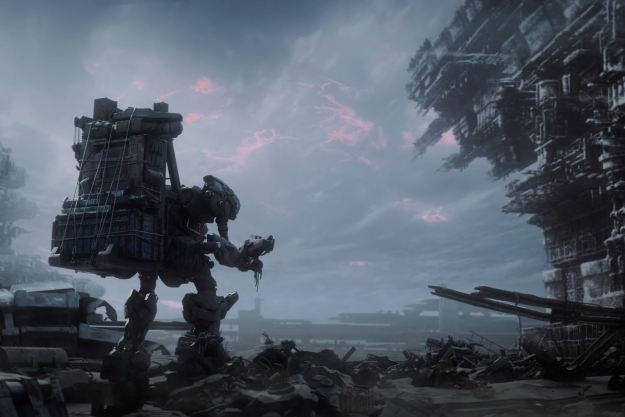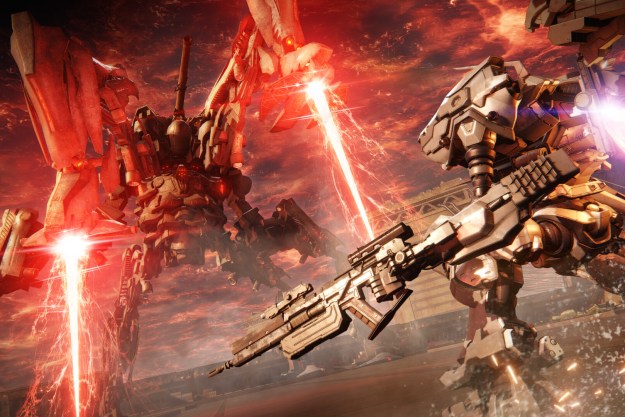
“Armored Core 6: Fires of Rubicon will impress fans of the mecha genre, but demanding controls and frustrating design quirks make for a tough sell for newcomers.”
- Fast movement
- Thrilling combat
- Flexible lock-on
- Excellent customization suite
- Dry storytelling
- Demanding controls
- Unwieldy camera
- Illegible UI
It only took three hours until Armored Core 6: Fires of Rubicon had me swearing up a storm.
The mech game’s first chapter concludes with a hellish boss fight against a helicopter capable of firing hundreds of rockets at a time while hiding behind a shield — all before somehow unleashing a pair of deadly flaming swords with impossibly long reach out of nowhere. After banging my head against the wall for hours, I wouldn’t find success until I stopped thinking like an action hero and started thinking like an engineer. With a few rounds of trial and error, I’d eventually piece together a mech that could withstand the assault and come out victorious. All I needed to do was toss out the weak links in my robot build and replace them with something stronger.
It’s an experience that perfectly encapsulates its creator, developer FromSoftware. The Dark Souls studio’s greatest strength lies in its ability to commit to a single idea, iterating until it finds the best version of its creation. When it challenges itself and slots something new into its steady foundation, we get groundbreaking works like Elden Ring. On the flip side, FromSoftware can be a victim of its own stubbornness. A headstrong refusal to swap out the most aged parts of its games can leave it charging into battle with a rusted machine.
Armored Core 6: Fires of Rubicon is a powerful mech flying with faulty thrusters. A fast-paced action game loaded with thrilling dogfights and stimulating mech customization is dragged down by all too familiar FromSoftware quirks like illegible UI and a headache-inducing third-person camera. It’s not enough to fully spoil an exciting ride, but it does leave me wondering how far a good tune-up would have gone.
Video review
In the cockpit
If it wasn’t clear from the jump, Armored Core 6 makes it immediately obvious that it’s not trying to rebuild the mecha series in Dark Souls’ image. It’s a mission-based action game where players set out on bite-sized operations in fairly flat maps that are light on detail. Each mission is set up with a briefing that moves a somewhat dull sci-fi narrative about a dangerous element called Coral that can be harnessed as a weapon of mass destruction. Writing isn’t really its strong suit outside of its final act, as hollow lore and military cliches (like a sergeant barking the word “maggot” in every scene he’s in) make for a forgettable narrative framing device that’s light on substance.
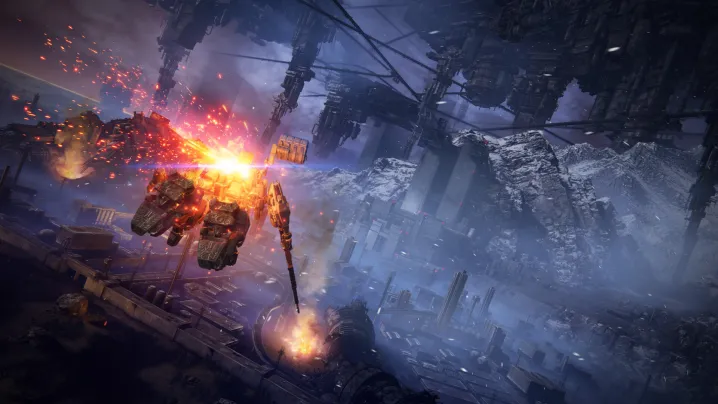
The experience gets far more compelling once actually getting behind the wheel of an enormous mech. There’s an immediate thrill to Armored Core 6 that’ll win some new fans right away. In my first mission, my jaw dropped when I realized I could boost forward at immense speeds that I usually only find in racing games. Not only that, but full omnidirectional control means that I can essentially fly in any direction too. Within moments, I was bought in as I sped past enemies and launched a barrage of missiles at them without taking my foot off the gas.
FromSoftware makes that experience as fluid as possible thanks to its flexible lock-on combat system. Rather than aiming at enemies to hit them, players only need to make sure they’re close to their large circular reticle when firing. That allows mechs to spray off tons of shots at once without getting too caught up in accuracy. It’s a streamlined system that keeps the explosives flowing rather than halting momentum, though it can be hard to gauge which attacks are actually going to land in more hectic encounters.
All of this makes for an effective action movie spectacle, though the framing around it isn’t quite as exciting.
And trust me, those encounters get mighty hectic. Despite operating a heavy, clunky robot, battles unfold at a lightning-fast pace. Smaller mechs zip around the screen like flies, while larger bosses have aggressive attack patterns that make Elden Ring’s bosses look lazy. It can be overwhelming to take in and significantly more demanding than your average game, but that makes its biggest set pieces feel all the more exhilarating. A level of focus is required that puts me squarely in the cockpit every time I pick up my controller.
All of this makes for an effective action movie spectacle, though the framing around it isn’t quite as exciting. When I’m not taking down enormous machines, I’m doing repetitive tasks like collecting data or easily wiping out smaller squads in visually bland spaces. There’s not much exploration to do inside of each mission’s small map and there are very few progression hooks to keep me moving forward. I don’t always feel a great sense of scale or power outside of boss fights either, as a lack of detail in both visuals and audio mixing often leaves me feeling like an action figure sliding around a playset. Despite being a fresh take on a classic series, there’s still a noticeable layer of old-school rust under all that modern sheen.
For the tinkerers
Though its presentation can feel dated, Armored Core 6 makes an impact when it comes to its detailed combat system. Each mech can be outfitted with a main weapon in each hand, including melee tools and explosives, and two shoulder cannons. When I’m deep in the flow of a battle, I’m able to keep a constant stream of bullets flowing as I stay mindful of each weapon’s cooldown. Aggression is the key to victory here (a more exciting inversion of the Souls formula), as battles are all about pressing advantages to melt down enemy stagger bars. It’s incredibly intense, especially when going up against other mechs in speedy dogfights that move between land and air.
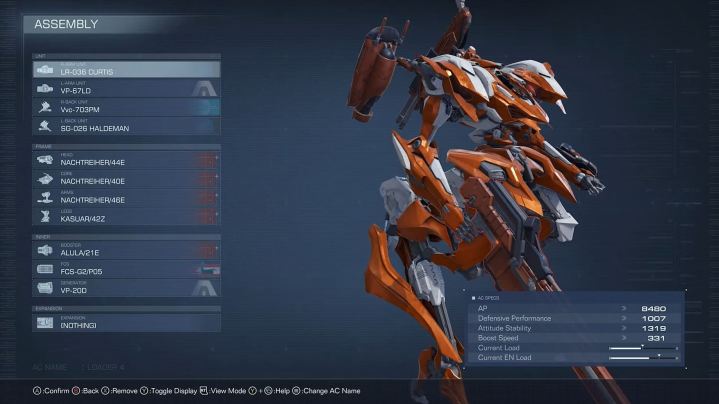
That pace is also what’s sure to keep the series in “acquired taste” territory, even with a more high-profile entry. With so much to manage, Armored Core 6 can be incredibly difficult to control. During some battles, I need to fly in the air by pressing A and turning with the left stick while firing four different weapons on my bumpers and triggers. With bosses constantly zipping around and a flimsy lock-on that doesn’t follow them, I also need to be constantly pivoting the camera with the right stick at all times. It’s physically exhausting, which alone creates a rather large barrier to entry in an already niche game.
What’s a little easier to manage, though, is an excellent robot customization system. That aspect is the real heart of the game more than any high-budget battles. Anytime I get my butt kicked by a rival machine, I head to the massive parts shop and start amassing everything from weapons to robot legs. Each one has a tangible impact on a slew of stats, but I need to make sure to manage my weight and power usage accordingly to power it all. That hook is stronger than the actual missions, as there’s a scientific joy to sticking parts together, testing them out in battle, and actually feeling that improvement. While there’s skill involved in fights, it’s not as much about “getting good” as it is about engineering a success.
Customization is an undeniable highlight here.
Granted, Armored Core 6 doesn’t do a very good job of telling players what their actual tools are. While parts feature tons of stats and numbers without much context, other key information simply isn’t in the game at all. There’s no explanation of damage types or how certain armor can resist different types of attacks. When I was struggling with the helicopter boss I mentioned earlier, I was only able to beat it with the help of a reviewer’s guide that detailed the nuances of damage types that are never explained in-game. It’s all annoyingly obtuse, which I’m sure will lead players to simply follow build guides. And that’s a shame because the act of building itself is the game itself.
Even with that frustration, customization is an undeniable highlight here. From beginning to end, I always got a kick out of equipping some new weapons onto my mech and testing out their viability on the battlefield. When one piece felt off, I’d swap it out for another to make incremental power gains I could actually feel. It’s the same satisfaction I feel when building a new gaming PC, except that PC spits out dozens of plasma missiles.
FromSoftware flaws
With FromSoftware’s recent rise to popularity, I imagine there’s going to be an impulse to revise history when it comes to Armored Core. Even before its launch, fans would have had you thinking that the series has always been revered, despite consistently earning middling scores from critics. Though this is the most polished version of the series to date, it’s still fairly easy to see why it’s always earned those mixed marks. A demanding framework combined with dated design makes for something that feels custom-built for enthusiasts and that holds up here.
What’s irksome, though, is that FromSoftware doesn’t seem very interested in welcoming interested pilots into the fold. That’s thanks to a wealth of familiar quality-of-life quirks that stand out more in an already friction-filled game. For instance, FromSoftware has always struggled when it comes to creating functional 3D cameras in its action games. Even something as immaculate as Elden Ring features cameras that get lost inside of enemies or obscure their attacks. Armored Core 6 has that same problem, but it’s amplified even more due to how fast enemies move, their omnidirectional motions, and a lack of lock-on that makes them difficult to track.
An incredibly hectic action game on top of frustrating design quirks that don’t always support its weight.
That alone turns most major boss battles into a nightmare — for all the wrong reasons. In one fight, I’m up against a spider robot that slides around on the floor. It’s a manageable fight until its second phase, where its legs turn into propellers and it flies high above me. At that point, I quite literally can’t see it anymore as it rains missiles down on me. When I try to fly up to meet it, I’ve got to fiddle with my camera while attempting to dodge attacks and ascend up to it. An otherwise reasonable fight becomes a battle with perspective.
If that didn’t tip you off to its developer, the dreadful UI will. The on-screen HUD is as tiny as can be, with weapon status shoved into the right corner of the screen in a basic, microscopic font. It’s near impossible for me to know when my weapons are reloading without glancing down to the very corner of the screen. But since battles move so fast, doing so is essentially suicide. In one of the game’s hardest fights, a battle against a tiny flying mech that’s already far too difficult to keep track of, I simply found myself hammering every attack button in order to stay alive while attacking. It’s downright illegible, further alienating anyone who’s not walking in as a master pilot.
It’s perhaps telling that the game’s best boss battle is its biggest outlier. In one mission, I need to fight an enormous robot snake that burrows in and out of a flat, icy terrain. When it rears its head up, I chuck an electrified spear at its open face to stun it. Doing so allows a far-off missile operator to call an airstrike on it, stunning it long enough for me to unleash a barrage of attacks as it lays dormant. It’s not just a thrilling fight, but one that feels better matched for those quirks. With a slower target that I can track and anticipate, I don’t have to fight with the camera just to see the thing. The more specific points of action mean I don’t need to keep a constant eye on my cooldowns either; I know when it’s safe to take my eye off the enemy and start managing weapons systems.
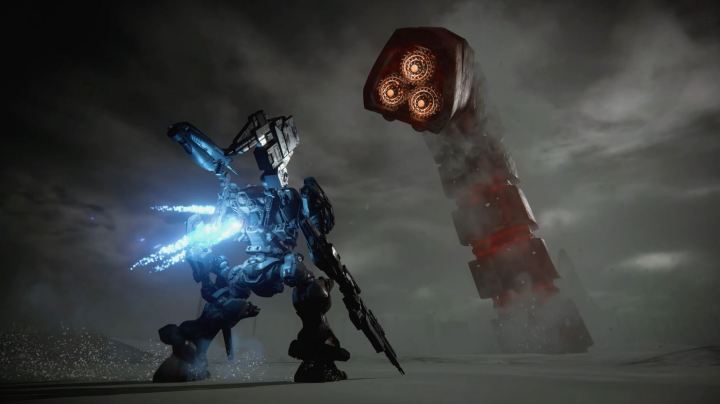
Make no mistake: the pain points I have here are also present in FromSoftware’s Souls games. They’re problems that kept me at arm’s length from some of its most beloved titles. However, those games often feel better built around the studio’s quirks. Cameras can get lost in big bosses, but those creatures don’t tend to zip around me at all angles while I’m fighting them. I can focus on what’s in front of me and put my effort into attack execution — and I don’t need to fiddle with the series’ obtuse menus to do that. It doesn’t feel like Armored Core 6 was built with that same level of thought, placing an incredibly hectic action game on top of frustrating design quirks that don’t always support its weight.
Perhaps that’s something one should expect from the first Armored Core game in 10 years. Sure, the studio has made a dozen of these, but I get the sense that the mission here was finding a way to get a dusty machine in working order again. Enough modern flourishes have been slotted in to make for a functional mecha game, one that fans of the genre will adore, but I can feel the pieces that need to be replaced if the series is going to survive long-term. Any impressive feat I accomplished in Armored Core 6 only came after a serious tune-up; I imagine the same will be true in the series’ next voyage, too.
Armored Core 6: Fires of Rubicon was reviewed on an Xbox Series X hooked up to a TCL 6-Series R635.
Editors' Recommendations
- How to beat IB-01:CEL 240 in Armored Core 6
- How to beat Balteus in Armored Core 6
- The best gear in Armored Core 6
- Every FromSoftware Soulsborne game, ranked
- Armored Core VI gameplay showcases intense mech fights, deep customization

